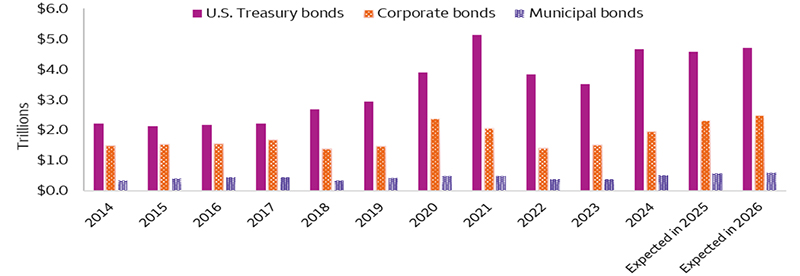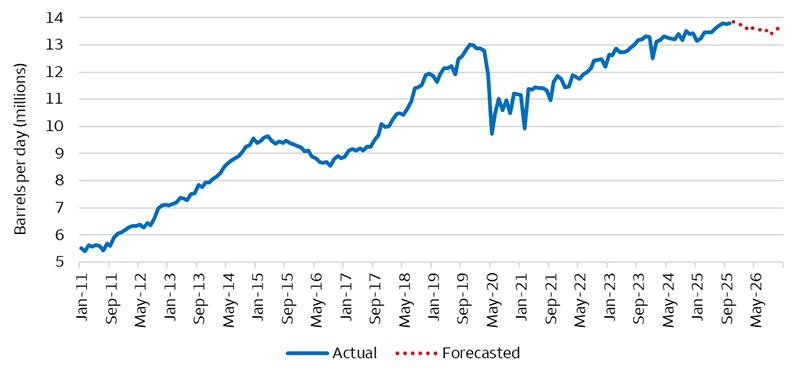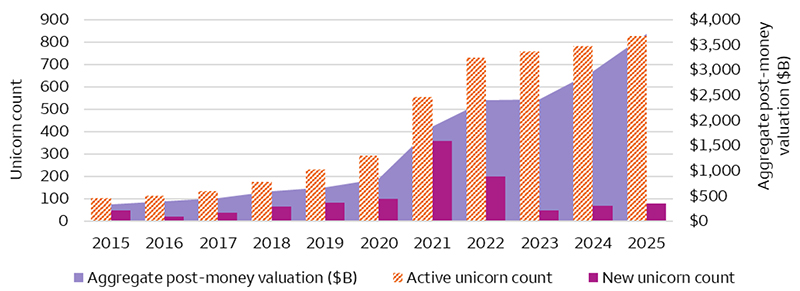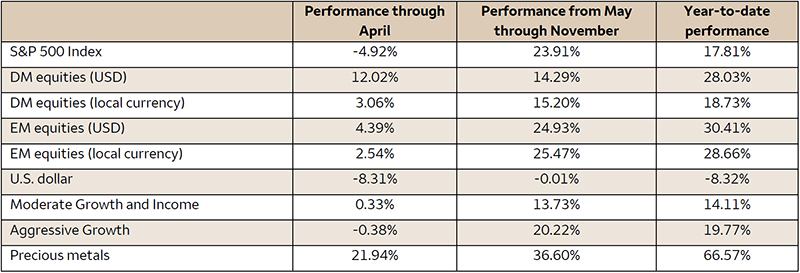Remain diversified with a U.S. focus
A major talking point this year has been the underperformance of the S&P 500 Index against international equities,2 along with the meteoric rise in gold. However, while the former has still outperformed the U.S. equity space through November, much, if not all, of that stems from the early months of the year. Through April, U.S. markets experienced declines given the significant tariff- and technology-related volatility. This allowed emerging market (EM) and developed market (DM) equities in local currency terms to outperform, with both, but the latter especially, boosted by a decline in the dollar’s strength.
Since then, the story has changed as tariffs have been both less significant and more delayed than markets had anticipated. Global equities have rallied, with the S&P 500 Index outperforming DM equities and lagging slightly behind EM equities from May through November. Meanwhile, the U.S. dollar ended the period little changed despite some intermittent volatility.
Diversified portfolios have benefited from international exposure (see Table 1). By the end of April, the Moderate Growth & Income (MGI) allocation, a hypothetical allocation that roughly would align to a 50% fixed income and 50% equities breakdown, was in positive territory compared to the S&P 500 Index (down nearly 5%). Year to date through November 30, the balanced MGI allocation is up double digits and competitive despite being lower risk. Meanwhile, the theoretical Aggressive Growth allocation (roughly 90% equity and 10% fixed income) was down less than half a percentage point through April and is currently outperforming the S&P 500 Index. The various sample allocations show the value in diversifying, helping to reduce downside risk and volatility while still maintaining strong performance.
Table 1. Year-to-date returns mask the changing story since April
|
Performance through April |
Performance from May through November |
Year-to-date performance |
| S&P 500 Index |
-4.92% |
23.91% |
17.81% |
| DM equities (USD) |
12.02% |
14.29% |
28.03% |
| DM equities (local currency) |
3.06% |
15.20% |
18.73% |
| EM equities (USD) |
4.39% |
24.93% |
30.41% |
| EM equities (local currency) |
2.54% |
25.47% |
28.66% |
| U.S. dollar |
-8.31% |
-0.01% |
-8.32% |
| Moderate Growth and Income |
0.33% |
13.73% |
14.11% |
| Aggressive Growth |
-0.38% |
20.22% |
19.77% |
| Precious metals |
21.94% |
36.60% |
66.57% |
Sources: © Morningstar Direct, All Rights Reserved
1, Bloomberg, and Wells Fargo Investment Institute. Data from January 1, 2025, to November 30, 2025. USD = U.S. dollar. Representative indexes include: MSCI EAFE Index, MSCI Emerging Markets Index, ICE U.S. Dollar Index, and Bloomberg Precious Metals Subindex. Performance results for Moderate Growth and Income and Aggressive Growth are calculated using blended index returns and for illustrative purposes only. Moderate Growth and Income and Aggressive Growth allocations are dynamic, and changes as needed with adjustments to the strategic allocations. Index returns do not represent investment performance or the results of actual trading. Index returns reflect general market results, assume the reinvestment of dividends and other distributions, and do not reflect deduction for fees, expenses or taxes applicable to an actual investment.
Past performance does not guarantee future results. Diversification does not guarantee investment returns or eliminate risk of loss. The risk associated with the representative asset classes and the definitions of the indexes and the blended index compositions are provided at the end of the report.
International equities generally served their role year to date as a diversifier and helped to preserve portfolio value during a difficult, volatile time, and providing a healthy boost to returns. We are constructive on equities as a whole given our global macro forecast for economic growth of 2.5%, but we do not expect further international outperformance during the tactical horizon, nor do we foresee any material lift from dollar declines, with the dollar currently in our year-end 2026 target range.
We prefer to remain internationally diversified and recommend a full, strategic weighting to both EM and DM ex-U.S. Equities. We continue to favor U.S. assets with overweights to U.S. Large and Mid Cap Equities, which we expect to benefit from a broadening of the AI (artificial intelligence) trend. Within the U.S., our favorable equity sectors — Financials, Industrials, and Utilities — we believe stand to gain from helping to finance data centers or being directly involved in their construction, maintenance, and management.
Turning to Precious Metals, gold has helped drive the class to exceptional returns despite a lull during the middle months of the year. While we are neutral on Commodities broadly, we are favorable on Precious Metals with exchange values for the dollar below the average values from 2022-2024 (as shown by the ICE U.S. Dollar Index)3, our expectation for further Fed rate cuts, and geopolitical uncertainty serving as tailwinds. We see material upside to our year-end 2026 target range for gold of $4,500 – $4,700 per troy ounce, though still a considerable step down from the gains this year.
2 As measured by the MSCI EAFE Index (developed markets) and the MSCI Emerging Markets Index.
3 The ICE U.S. Dollar Index is a weighted average of the value of the U.S. dollar relative to a basket of U.S. trade partner currencies, composed of the euro, Japanese yen, pound sterling, Canadian dollar, Swedish krona, and Swiss franc.
Custom silicon TPUs versus general purpose GPUs
The competitive Gemini 3 Pro large language model, released in November, is trained on a specific type of custom silicon, known as Tensor Processing Units (TPUs) and has sparked a debate as to whether custom application-specific integrated circuits (ASICs) will eventually displace general purpose GPUs.
For the last decade plus, the largest hyperscale cloud providers have been allocating financial resources to fund their own internal custom ASIC chips to rely less on foundational GPU chips. Despite these efforts, custom ASICs have been on average about a year to two years behind GPUs, in terms of performance.
An ASIC is an integrated circuit custom designed to address a particular task or AI application. ASICs can be designed for either AI training or inference purposes. Custom ASICs are typically less cost prohibitive than general purpose GPUs and generally are more power efficient, resulting in a lower total cost of ownership.
We do not believe custom ASICs will win or lose relative to GPUs. We believe the AI accelerator marketplace is large enough and growing fast enough for both AI silicon solutions to do reasonably well. The largest GPU supplier has visibility to hundreds of billions of dollars of revenue through the end of calendar-year 2026.
From a high level, our investment strategy guidance holds a neutral view on the Information Technology sector. AI workloads remain highly compute,4 networking and semiconductor intensive — which we believe supports our favorable view on the Semiconductors sub-sector. We expect leading semiconductor companies to benefit from supporting the ongoing AI infrastructure buildout. Please see chart 1.
Chart 1. Worldwide Semiconductor revenue by end market
Sources: ASML and Wells Fargo Investment Institute. Data as of March 2025. *E = estimated. Estimates are forecasted figures by ASML.
4 Computing resources required.
Bond issuance should remain elevated in 2026
Recent news headlines have highlighted the strong issuance of investment-grade corporate bonds in 2025, mostly focusing on large technology companies raising funds to deploy into the AI capital spending. But paying closer attention, we can observe that U.S. Treasury issuance has remained steady while municipal issuers have also increased supply. Our expectation is that issuance in 2026 is poised to increase across these three major fixed income sectors, driven primarily by persistent U.S. fiscal deficits, an AI capex supercycle in the corporate market, and diminishing post-pandemic reserves of major muni issuers. While we anticipate the fixed-income market to absorb this volume, demand will likely be yield-sensitive, most likely demanding higher premiums to clear the supply.
Issuance Forecasts by Sector
- U.S. Treasuries should remain the largest share of issuance. With U.S federal deficits projected between $2.2 trillion and $2.4 trillion for fiscal year 2026, net issuance will remain near historical highs. Also, keep in mind that additional U.S. Treasury bill issuance will play a key role (by the middle of January 2026, Treasury anticipates increasing bill auction sizes based on expected fiscal outflows).
- We anticipate corporate bond issuance, particularly in the investment grade sector, to rise as companies continue to tap into debt to finance AI related infrastructure development. We also expect merger and acquisitions activity to pick up in 2026.
- We think municipal bonds will most likely tap into debt markets to help them finance infrastructure needs largely tied to AI capex.
In our view, there is still sufficient liquidity and investor demand to absorb the imminent supply wall. Record issuance in 2026 is another key reason why we believe it will be difficult for bond yields to fall, even if the Fed cuts short-term policy rates.
Chart 2. We anticipate bond issuance to rise in 2026
Sources: SIFMA and Wells Fargo Investment Institute Research, December 2, 2025. Data as of November 30, 2025. U.S. Treasury bond include long-term only, interest bearing marketable coupon public debt; includes floating rate notes. Corporates = corporate bonds; all non-convertible and convertible debt, MTNs and Yankee bonds. Municipal securities are long-term only. “Expected” are forecasted figures by Wells Fargo Investment Institute. Yankee bonds are dollar bonds issued in the U.S. by foreign entities. MTNs = Medium-term notes.
Peak U.S. oil production
Following robust growth over the past 15 years, we believe that U.S. oil production is nearing an inflection point and entering a “low to no growth” era, as evidenced by the Energy Information Administration’s forecast5 for domestic crude oil production volumes to be flat in 2026.
For investors, we appreciate the oil industry’s shift to a more conservative oil supply strategy, but we do not expect this to result in higher oil prices in the near term. This is primarily because lower U.S. production growth is being offset in the global market by increased offshore production from other regions, as well as further potential supply increases from OPEC+.6 However, if global oil demand growth improves throughout 2026, consistent with our views of strengthening macroeconomic conditions, this could eventually contribute to firmer oil prices later in the year.
We maintain a neutral view of the Energy sector. We believe the sector offers good value as a hedge against inflation and geopolitical risks, yet we acknowledge that the sector may struggle to outperform in the near term due to perceived risks of global crude oil oversupply. In our view, the shift to a “low to no growth” strategy has made large U.S. Energy producers more resilient, and we also expect the sector to benefit from secular growth in natural gas demand and recent strength in refining margins. We continue to prefer a diversified approach towards investing in the sector, which underscores our favorable subsector views of Integrated Oil and Midstream Energy companies.
Chart 3. U.S. crude oil production
Source: U.S. Energy Information Administration. Data as of November 12, 2025.
5 U.S. Energy Information Administration, “Short-Term Energy Outlook,” November 12, 2025.
6 Organization of the Petroleum Exporting Countries.
The rise in venture-capital unicorns
Today, many companies are choosing to stay private longer.7 The decision to remain private may be influenced by several factors, including:
- Long-term focus: Ability to focus on longer-term strategic plans, rather than shorter-term financial results.
- Lower regulatory burden: Potential to avoid the added cost of regulatory reporting requirements.
- Access to capital: The growth in private markets has lessened the need for companies to transition to public markets for funding.
Within Private Equity, VC can play a key role in supporting early-stage businesses. These companies are expected by VCs exhibit rapid growth that may involve new product development or proof of concept. This segment carries greater risk of business failure, but we believe it also offers attractive return potential for the added risk. As shown in Chart 4, this trend of companies staying private longer has been evident by the rise in VC unicorns, defined as startup companies with valuations exceeding $1 billion. The number of active VC unicorns nears 830, up from only 104 in 2015. Moreover, the aggregate valuation has grown from $340 million in 2015 to over $3.7 trillion as of September 30, 2025.8 This rise in VC unicorns suggests companies are often foregoing a transition to public markets until their valuations surpass the typical startup.
For qualified investors, we believe that private-market exposure remains critical to accessing these high-growth opportunities. However, competition for leading VC investments is intense. While some companies will thrive, many may struggle to gain traction as entrepreneurs race to integrate AI technologies across industries. For those qualified investors who are comfortable with the risks9, they may consider an allocation across private and public markets to gain exposure to an array of potential opportunities.
Chart 4. The growth in venture capital unicorns illustrates the recent trend of companies staying private longer
Sources: Pitchbook and Wells Fargo Investment Institute. Data as of September 30, 2025. B = billions
Alternative investments, such as hedge funds, private equity, private debt and private real estate funds are not appropriate for all investors and are only open to “accredited” or “qualified” investors within the meaning of U.S. securities laws.
7 Source: Pitchbook | NVCA Venture Monitor – Q3 2025.
8 Post-money valuation is defined as a company's estimated worth after outside financing and/or capital injections are added to its balance sheet, used as a measure of its approximate market value.
9 Risks such as illiquidity, lock up periods, high fees and low transparency – see full risk disclosure at end of report.
Cash Alternatives and Fixed Income
intentionally blank
intentionally blank
intentionally blank
| Most Unfavorable |
Unfavorable |
Neutral |
Favorable |
Most Favorable |
|
intentionally blank
|
- U.S. Long Term Taxable Fixed Income
- U.S. Short Term Taxable Fixed Income
|
- Cash Alternatives
- Developed Market Ex-U.S. Fixed Income
- Emerging Market Fixed Income
- High Yield Taxable Fixed Income
|
- U.S. Intermediate Term Taxable Fixed Income
|
intentionally blank
|
Equities
| Most Unfavorable |
Unfavorable |
Neutral |
Favorable |
Most Favorable |
|
intentionally blank
|
|
- Developed Market Ex-U.S. Equities
- Emerging Market Equities
|
- U.S. Large Cap Equities
- U.S. Mid Cap Equities
|
intentionally blank
|
Real Assets
| Most Unfavorable |
Unfavorable |
Neutral |
Favorable |
Most Favorable |
|
intentionally blank
|
intentionally blank
|
- Commodities
- Private Real Estate
|
|
intentionally blank
|
Alternative Investments**
| Most Unfavorable |
Unfavorable |
Neutral |
Favorable |
Most Favorable |
|
intentionally blank
|
intentionally blank
|
- Hedge Funds—Equity Hedge
- Hedge Funds—Macro
- Hedge Funds—Relative Value
- Private Equity
- Private Debt
|
|
intentionally blank
|
Source: Wells Fargo Investment Institute, December 8, 2025.
*Tactical horizon is 6-18 months
**Alternative investments are not appropriate for all investors. They are speculative and involve a high degree of risk that is appropriate only for those investors who have the financial sophistication and expertise to evaluate the merits and risks of an investment in a fund and for which the fund does not represent a complete investment program. Please see end of report for important definitions and disclosures.




 Sources: ASML and Wells Fargo Investment Institute. Data as of March 2025. *E = estimated. Estimates are forecasted figures by ASML.
Sources: ASML and Wells Fargo Investment Institute. Data as of March 2025. *E = estimated. Estimates are forecasted figures by ASML. Sources: SIFMA and Wells Fargo Investment Institute Research, December 2, 2025. Data as of November 30, 2025. U.S. Treasury bond include long-term only, interest bearing marketable coupon public debt; includes floating rate notes. Corporates = corporate bonds; all non-convertible and convertible debt, MTNs and Yankee bonds. Municipal securities are long-term only. “Expected” are forecasted figures by Wells Fargo Investment Institute. Yankee bonds are dollar bonds issued in the U.S. by foreign entities. MTNs = Medium-term notes.
Sources: SIFMA and Wells Fargo Investment Institute Research, December 2, 2025. Data as of November 30, 2025. U.S. Treasury bond include long-term only, interest bearing marketable coupon public debt; includes floating rate notes. Corporates = corporate bonds; all non-convertible and convertible debt, MTNs and Yankee bonds. Municipal securities are long-term only. “Expected” are forecasted figures by Wells Fargo Investment Institute. Yankee bonds are dollar bonds issued in the U.S. by foreign entities. MTNs = Medium-term notes. Source: U.S. Energy Information Administration. Data as of November 12, 2025.
Source: U.S. Energy Information Administration. Data as of November 12, 2025. Sources: Pitchbook and Wells Fargo Investment Institute. Data as of September 30, 2025. B = billions
Sources: Pitchbook and Wells Fargo Investment Institute. Data as of September 30, 2025. B = billions